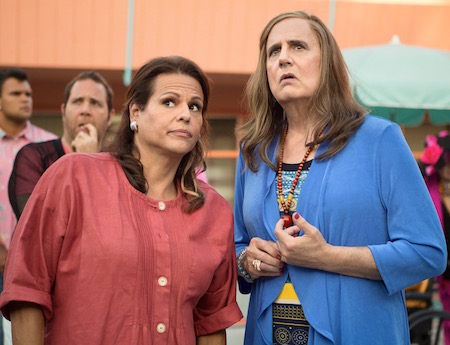NATPE 2016: The Ups and Downs of Peak TV

Complete Coverage: NATPE 2016
There are upsides and downsides to peak TV, according to the opening panel at NATPE 2016 in Miami Beach on Tuesday.
On one hand, so much TV means creators have more opportunities than ever to develop and produce complex, nuanced scripted programming. On the other hand, the market glut means that content is increasingly difficult to monetize.
And just because there are 409 scripted series on television and growing, doesn’t mean that all of it is worth watching – or producing. But TV producers asked: for whom is too much TV really a problem?
“We seem to be the only part of the culture that bemoans an abundance of quality programming,” said Gary Levine, president of programming for Showtime. “What’s the problem? If features have a great season, the Academy expands the category for Best Picture from five to 10. You don’t hear people say, ‘I just have too many great restaurants in my neighborhood.’ What it does do is make us have to be better at our jobs of developing shows."
But programmers on the panel from streaming services and premium networks did say the bar is getting harder and harder to meet.
“The broadcast networks are in the business of being 10 to 12 million people’s third favorite show. We are not. We are in the business of being people’s favorite show,” said Morgan Wandell, head of drama development for Amazon Studios, which this year again won the Golden Globe for best TV comedy with Mozart in the Jungle. Last year, Amazon won its first Golden Globes for Transparent and for that show’s star, Jeffrey Tambor.
Broadcasting & Cable Newsletter
The smarter way to stay on top of broadcasting and cable industry. Sign up below
What attracts creators such as Transparent’s Jill Soloway and The Affair’s Sarah Treem to premium networks is the chance to keep their creative vision under their control.
“The place where people want to go least is broadcast television,” said Peter Benedek, founding partner and board member, UTA. "Amazon, Netflix, Showtime, HBO, etc., all offer places in which [creatives] are very interested. Creative talent are prepared to go anywhere and everywhere.”
And while broadcast TV may not currently represent the pinnacle of creative independence, it’s still the most lucrative place to sell a show.
“The pot of gold is still a broadcast network hit,” said Showtime’s Levine. “But [creators] are willing to go somewhere else for creative freedom. I would argue that the most profitable show of the past 10 years is The Big Bang Theory but there’s no premium network or streaming service trying to emulate that show. It’s a positive comment on talent and audiences that premium is the most desirable form, even though it’s not necessarily the most lucrative.”
While having so much high-end content available is great for consumers, it’s less so for producers.
“It’s really much more difficult to monetize content today than it was five years ago,” said Sandra Stern, president of Lionsgate Television Group. “With the syndication market, especially for cable, drying up and the vast number of platforms dividing the audience, it’s much more difficult to monetize the programming. A homerun is much more difficult to get today than five years ago.”
“As a studio, it’s great for us,” said Charlie Corwin, co-CEO of Endemol Shine North America who just added cochairman of Endemol Shine Americas to his title. “We have a lot more buyers to sell to and more buyers around the world.”
Another trend some of the panelist questioned was binge-viewing: “Consider the word binge,” said Mark Greenberg, CEO and president of EPIX. “Now consider any context in which it’s considered a good word: binge-eating, binge-drinking, binge-sleeping, binge-watching."
“Why is binge-viewing good? You lose control of the conversation when people are watching your shows all at once,” he continued. "At one level, it’s a 10-hour movie that shows up one day. Or it’s 10 weeks through which I can cross-promote my brand and my network to other things. As a business matter, that helps consumers see the rest of what we do. I think what we’re doing with binge-viewing is giving away [that control.]”
In the end – whether you’re a buyer or a seller, a network or a streamer, a binge-programmer or a week-to-week one – the goal remains the same: to have a hit.
Said Greenberg: “As long as you can deliver great content, you’ll always find an audience. As more and more people are creating access to great intellectual property and if you can produce that in a qualitative way, you’ll find an audience.”
Contributing editor Paige Albiniak has been covering the business of television for more than 25 years. She is a longtime contributor to Next TV, Broadcasting + Cable and Multichannel News. She concurrently serves as editorial director for The Global Entertainment Marketing Academy of Arts & Sciences (G.E.M.A.). She has written for such publications as TVNewsCheck, The New York Post, Variety, CBS Watch and more. Albiniak was B+C’s Los Angeles bureau chief from September 2002 to 2004, and an associate editor covering Congress and lobbying for the magazine in Washington, D.C., from January 1997 - September 2002.










